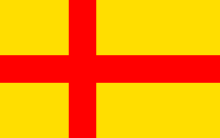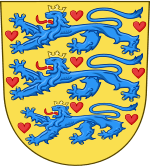Kalmar Union
The Kalmar Union (Danish, Norwegian, and Swedish: Kalmarunionen; Latin: Unio Calmariensis) was a personal union in Scandinavia that from 1397 to 1523[1] joined under a single monarch the three kingdoms of Denmark, Sweden (then including most of Finland), and Norway, together with Norway's overseas dependencies (then including Iceland, Greenland,[N 1] the Faroe Islands, and the Northern Isles). The union was not quite continuous; there were several short interruptions. Legally, the countries remained separate sovereign states, but with their domestic and foreign policies being directed by a common monarch. Gustav Vasa's election as king on 6 June 1523 and his triumphant entry into Stockholm eleven days later marked Sweden's final secession from the Kalmar Union.[2]
Kalmar Union | |||||||||||||||||
|---|---|---|---|---|---|---|---|---|---|---|---|---|---|---|---|---|---|
| 1397–1523 | |||||||||||||||||
 "Banner of the realms" as described by Eric of Pomerania in 1430
.svg.png) Arms of Christian I, John & Christian II
| |||||||||||||||||
 The Kalmar Union, c. 1400 | |||||||||||||||||
| Status | Personal union | ||||||||||||||||
| Capital |
| ||||||||||||||||
| Common languages |
| ||||||||||||||||
| Religion |
| ||||||||||||||||
| Government | Personal union | ||||||||||||||||
| Regent | |||||||||||||||||
• 1387–1442a | Eric III, VII & XIII (first) | ||||||||||||||||
• 1513–23b | Christian II (last) | ||||||||||||||||
| Legislature | Riksråd and Herredag (one in each kingdom) | ||||||||||||||||
| Historical era | Late Middle Ages | ||||||||||||||||
• Inception | 17 June 1397 | ||||||||||||||||
| 1434–1436 | |||||||||||||||||
| November 1520 | |||||||||||||||||
| 6 June 1523 | |||||||||||||||||
• Dissolution | 1523 | ||||||||||||||||
| Currency | Mark, Örtug, Norwegian penning, Swedish penning | ||||||||||||||||
| |||||||||||||||||
| Today part of | |||||||||||||||||
| |||||||||||||||||
| Part of a series on |
| Scandinavia |
|---|
|
Geography |
Inception
The union was the work of Scandinavian aristocracy wishing to counter the influence of the Hanseatic League. More personally, it was achieved by Queen Margaret I of Denmark (1353–1412). She was a daughter of King Valdemar IV and had married King Haakon VI of Norway and Sweden, who was the son of King Magnus IV of Sweden, Norway and Scania. Margaret succeeded in having her son Olaf recognized as heir to the throne of Denmark. In 1376 Olaf inherited the crown of Denmark from his maternal grandfather as King Olaf II, with his mother as guardian; when Haakon VI died in 1380, Olaf also inherited the crown of Norway.[3]
Margaret became regent of Denmark and Norway when Olaf died in 1387, leaving her without an heir.[4] She adopted her great-nephew Eric of Pomerania the same year.[5] The following year, 1388, Swedish nobles called upon her help against King Albert.[6] After Margaret defeated Albert in 1389, her heir Eric was proclaimed King of Norway.[4] Eric was subsequently elected King of Denmark and Sweden in 1396.[4] His coronation was held in Kalmar on 17 June 1397.[7]
One main impetus for its formation was to block German expansion northward into the Baltic region. The main reason for its failure to survive was the perpetual struggle between the monarch, who wanted a strong unified state, and the Swedish and Danish nobility, which did not.[8] Diverging interests (especially the Swedish nobility's dissatisfaction with the dominant role played by Denmark and Holstein) gave rise to a conflict that would hamper the union in several intervals starting in the 1430s. Charles Bonde, for example, was made king of Sweden three times by nationalists there, in 1440, 1464 and 1467.
End and aftermath
The Union lost territory when the Northern Isles were pledged by Christian I, in his capacity as King of Norway, as security against the payment of the dowry of his daughter Margaret, betrothed to James III of Scotland in 1468. However the money was never paid, so in 1472 the islands were annexed by the Kingdom of Scotland.[9]
The Kalmar union fell apart when Sweden rebelled and became independent on 6 June 1523 and Gustav I of Sweden was elected as king there.
One of the last structures of the Union remained until 1536/1537 when the Danish Privy Council, in the aftermath of the Count's Feud, unilaterally declared Norway to be a Danish province: this did not happen; instead, Norway became a hereditary kingdom in a real union with Denmark.[10][11] Norway continued to remain a part of the realm of Denmark–Norway under the Oldenburg dynasty for nearly three centuries, until it was transferred to Sweden in 1814. The ensuing union between Sweden and Norway lasted until 1905, when a grandson of both the incumbent king of Denmark and the late king of Sweden was elected king of Norway.
See also
- List of Kalmar Union monarchs
- Scandinavian royal lineage chart for the time around the founding of the Kalmar Union
Notes
- Nominal possession. There was no European contact with the island during the Kalmar Union period.
References
- Harald Gustafsson, "A State that Failed?" Scandinavian Journal of History (2006) 32#3 pp 205–220
- Anastacia Sampson. "Swedish Monarchy – Gustav Vasa". sweden.org.za. Retrieved 1 August 2018.
- Karlsson, Gunnar (2000). The History of Iceland. p. 102.
- "Margaret I | queen of Denmark, Norway, and Sweden". Encyclopedia Britannica. Retrieved 5 June 2017.
- "Erik VII | king of Denmark, Norway, and Sweden". Encyclopedia Britannica. Retrieved 5 June 2017.
- "Sweden – Code of law | history – geography". Encyclopedia Britannica. Retrieved 5 June 2017.
- "Kalmar Union | Scandinavian history". Encyclopedia Britannica. Retrieved 5 June 2017.
- For a somewhat different view see Steinar Imsen, "The Union of Calmar: Northern Great Power or Northern German Outpost?" in Christopher Ocker, ed. Politics and Reformations: Communities, Polities, Nations, and Empires (BRILL, 2007) pp 471–72
- Nicolson (1972) p. 45
- Moseng, Ole Georg (2003). Norges historie 1537-1814. Universietsforlaget AS. p. 27. ISBN 978-82-15-00102-9.
- Nordstrom, Byron (2000). Scandinavia since 1500. University of Minnesota Press. p. 147. ISBN 0-8166-2098-9.
Further reading
- Albrectsen, Esben, Fælleskabet bliver til. Danmark-Norge 1380–1814, vol. 1, 1380–1536, Oslo: Universitetsforlaget, 1997
- Carlsson, Gottfrid, Medeltidens nordiska unionstanke, Stockholm: Gebers, 1945
- Christensen, Aksel E., Kalmarunionen og nordisk politik 1319–1439, Copenhagen: Gyldendal, 1980
- Enemark, Poul, Fra Kalmarbrev til Stockholms blodbad. Den nordiske trestatsunions epoke 1397–1521, Copenhagen: Nordisk ministerråd/Gyldendal/Liber, 1979
- Gustafsson, Harald. "A State that Failed?" Scandinavian Journal of History (2006) 32#3 pp 205–220 online; general overview of the Union
- Harald Gustafsson (2017) The Forgotten Union, Scandinavian Journal of History, 42:5, 560–582.
- Dick Harrison (2020) Kalmarunionen ISBN 978-91-7789-167-3
- Helle, Knut, ed. The Cambridge History of Scandinavia, Volume 1: Prehistory to 1520 (2003) excerpt and text search
- Imsen, Steinar. "The Union of Calmar: Northern Great Power or Northern German Outpost?" in Christopher Ocker, ed. Politics and Reformations: Communities, Polities, Nations, and Empires (BRILL, 2007) pp 471–90 online
- Kirby, David. Northern Europe in the Early Modern Period. The Baltic World 1492–1772 (1990)
- Larsson, Lars-Olof, Kalmarunionens tid. Från drottning Margareta till Kristian II, Stockholm: Rabén-Prisma, 1997
- Roberts, Michael. The Early Vasas: A History of Sweden 1523–1611 (1968)
External links
| Wikimedia Commons has media related to Kalmar Union. |
- The Kalmar Union – Maps of the Kalmar Union



